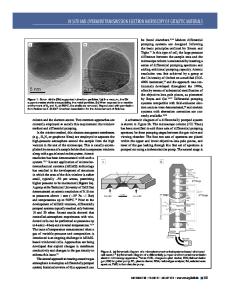In Situ Heating Transmission Electron Microscopy
- PDF / 1,132,822 Bytes
- 8 Pages / 612 x 792 pts (letter) Page_size
- 19 Downloads / 521 Views
Transmission Electron Microscopy
Hiroyasu Saka, Takeo Kamino, Shigeo Arai, and Katsuhiro Sasaki Abstract Temperature is one of the most important factors affecting the state and behavior of materials. In situ heating transmission electron microscopy (TEM) is a powerful tool for understanding such temperature effects, and recently in situ heating TEM has made significant progress in terms of temperature available and resolution attained. This article briefly describes newly developed specimen-heating holders, which are useful in carrying out in situ heating TEM experiments. It then focuses on three main applications of these specimen holders: solid–solid reactions, solid–liquid reactions (including highresolution observation of a solid–liquid interface, size dependence of the melting temperatures of one-, two- and three-dimensionally reduced systems, size dependence of the contact angle of fine metal liquid, and wetting of Si with liquid Au or Al) and solid–gas reactions. These results illustrate the benefit of in situ heating TEM for providing fundamental information on temperature effects on materials.
Introduction Transmission electron microscopy (TEM) enables materials observation with spatial and chemical resolution at the atomic level. During in situ heating TEM experiments, the samples are heated (and cooled), so that the dynamics of phase transformations and reactions at high temperatures can be directly observed in situ. One of the main limitations of in situ heating TEM is the high vacuum in which the specimens are contained. Thus, for instance, observations of reactions containing liquid and/or gas have been difficult to carry out or have been made at the sacrifice of spatial and chemical resolution. Recently, however, in situ heating TEM techniques have made such significant progress that some of the past difficulties have been successfully overcome.
Specimen-Heating Holders for Successful In Situ TEM The two most important features required for in situ TEM heating are the ability to reach high temperatures and the thermal, as well as mechanical, stability of the system at high temperatures. Needless to say, any instability of the holder causes
a drift of the specimen. In addition, if the maximum heating temperature achievable by the holder is low, the application range will be limited. Therefore, the design of the specimen-heating holder is the most crucial issue for performing in situ heating TEM experiments. Because a TEM specimen is normally prepared in a 3-mm-diameter disk, most of the specimen-heating holders designed hitherto have a cylindrical miniature furnace in which the 3-mm-diameter specimen is mounted. The periphery of the furnace is water-cooled to minimize inadvertent heating of the surrounding components and specimen drift, especially when the heating temperature is higher than, say, 800°C. However, it often takes 1–2 hours for the specimen to stabilize after the temperature is reached. Furthermore, the maximum temperatures available with this type of heating holder are limited to 10
Data Loading...











